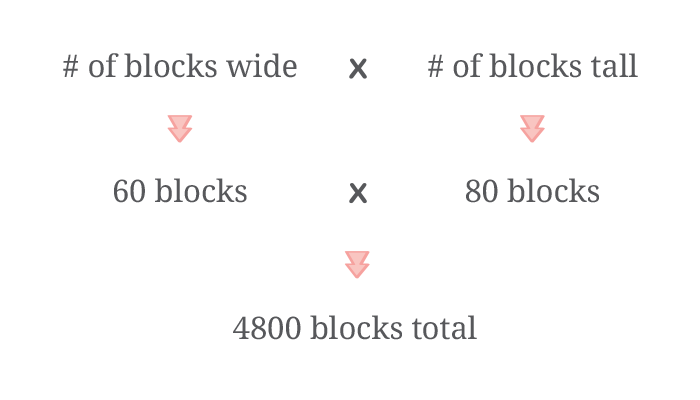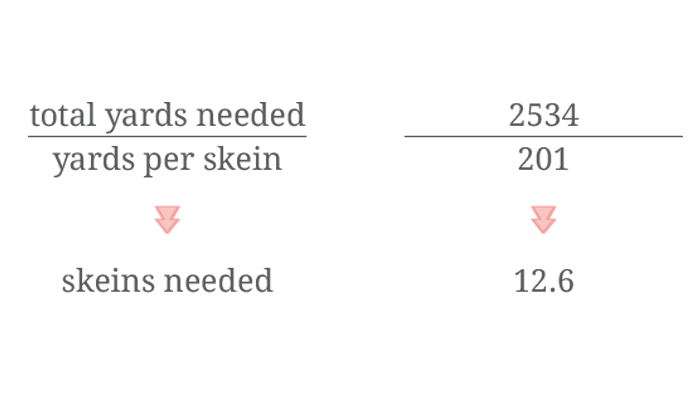There are two questions I get asked pretty frequently
- How much yarn do I need for my blanket?
- How do I know how big it will be?
Well, the answers require a little bit of information about your blanket, your yarn, and your gauge, which means that they will change depending on how and what you’re stitching. We all know that I’m pretty long winded, so I tried to provide the same information in the images as I did in the text, so you could follow along without reading forever. It’s not as complicated and scary as it looks, I promise! So, let’s get started!
For each of my patterns, I work up 2 different equations. The first is to find out how many stitches/stitch groups I need to make the pattern I want to achieve. So, let’s start there.
First, you need to know what size you’re looking to achieve. For our example, we’ll use a crib blanket, which are 45″ x 60″ Because you’ll be using your own measurements, you don’t need to convert to imperial if you’re not in the US. Your conversion at the end will just be a little different.
You’ll need to work up a gauge swatch the the yarn, stitch and hook size you want to use. If you don’t have the yarn specifically, find one that’s close in weight and use that.
To find out how many stitches/stitch groups your pattern needs to be, you’ll need to divide the length and width by the length and width of your stitch.

The majority of my custom blankets are C2Cs and are the most commonly asked about. So, for our equations, we’re going to work with “blocks” – referring to the block of (ch 3, 3 DC) in each square of a C2C. To find the dimensions of each block, I work 2 rows of the C2C graphgan and measure the first 1 x 1 row. It’s important to measure your stitches/stitch sets as they would appear in the blanket, so for C2C, you need to have a row worked above, and for single stitch graphgan blankets (SC, HDC, DC, etc) you need to work 3 rows, then measure the middle one. We do this to compensate for a small portion of the next row covering part of the top of the stitch, or, in the case of a C2C, squaring off the stitch properly.
Now that we know how many blocks of each we need, we can create our pattern and find out how much yarn we will need to complete it. If your blanket is a single color, you can use the total number of stitches/stitch sets. If your blanket is multiple colors, you’ll need to know how many stitches/stitch sets there are of each color. If you use a program like PC Stitch or WinStitch to work up your graphgan patterns, the software will tell you how many stitches of each there are. If not, you might have to count.
TIP : Work smart, not hard. If your pattern has a small design in the middle, remember that you can find the number of stitches in the design itself, then subtract all those stitches from the total stitches of the blanket to save yourself counting the outside of your design.
To find the total number of stitches, you need to multiply the number of stitches wide by the number of stitches tall (area = length x width).

The last measurement you will need, is how much yarn it takes to make your stitch/stitch set. To do this, I hold the end of the yarn tail on the last stitch I made, pull one stitch/stitch set out, and measure from my fingers to the next stitch. So, you’ll be measuring the yarn to make 1 full stitch, or in the case of a C2C block, the amount for the block (the ch 3 and 3 DCs). We’ll be using inches in this case.

We’re in the home stretch I promise! This is the part that I mentioned would be different if you are not using the imperial system. We need to convert the inches of yarn we found, to yards – the measurement used in skeins. The easiest way to do this is to input “inches to yards” in google, and have it calculate it for you. But you can convert it by hand by dividing your total inches of yarn by 36 (There are 12 inches in a foot and 3 feet make a yard – 12 in x 3 ft = 36 in = 1 yard)

Now, last but definitely not least, we find out how many skeins! All you need to do, is divide the number of yards you need by the number of yards in the skein of yarn you’d like to use. For our example, we’ll use Paintbox Aran, which has 201 yrds each.

Voila! Remember to always round up to the next skein, even if it’s a small amount of yarn. I always order 1 extra of skeins that are close or heavily used to compensate for yarn lost due to cutting color changes or inconsistency in gauge. Also make sure that you compensate for a border if you’d like to add one.
Happy Stitching!

